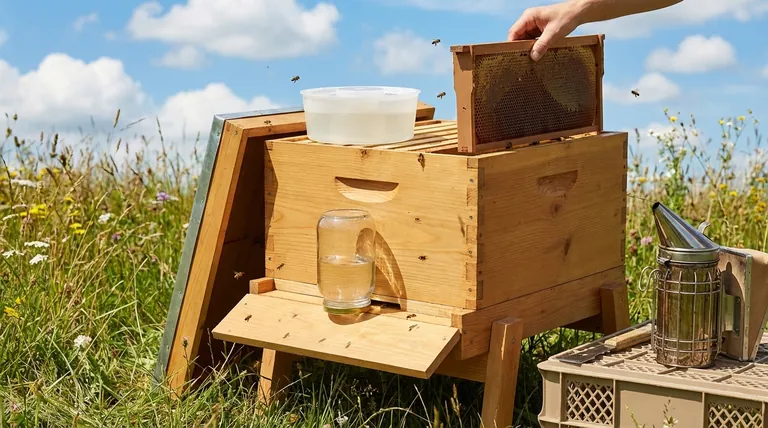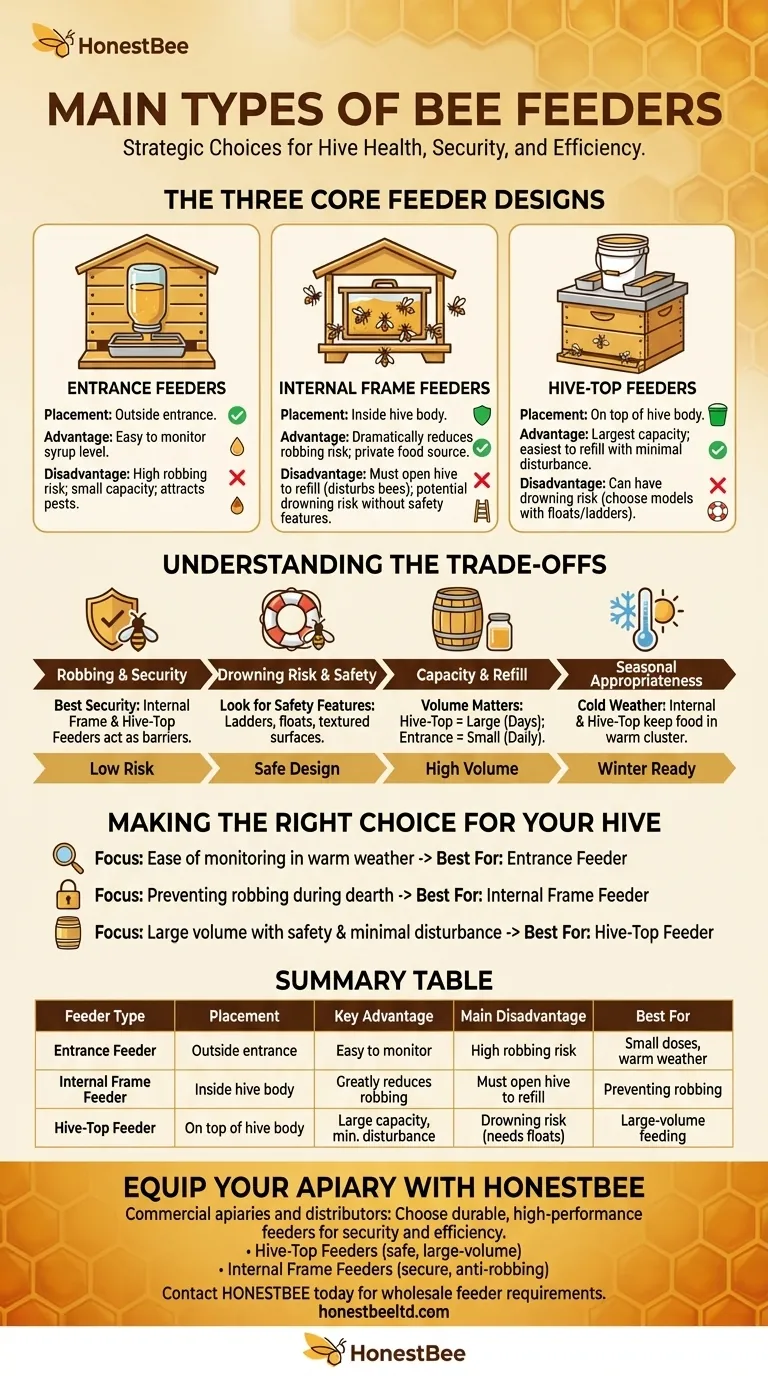The primary types of bee feeders are entrance feeders, internal frame feeders, and hive-top feeders. Each design fits inside, outside, or on top of the hive, offering a distinct method for delivering syrup to the colony. Your choice depends on the season, the size of your colony, and your goals as a beekeeper.
The "best" bee feeder is not a single product, but a strategic choice. The right feeder balances your convenience with the core needs of the hive: safety from drowning, security from predators, and access to food with minimal disruption.

The Three Core Feeder Designs
Understanding how each feeder works is the first step. The three main categories are defined by their placement relative to the hive body. This placement dictates their primary advantages and disadvantages.
Entrance Feeders (Boardman Feeders)
An entrance feeder is an external system, typically a small glass jar or plastic container inverted into a tray that fits into the hive's entrance. Bees leave the hive and walk a short distance on the tray to access the syrup.
These feeders are very simple to set up and use. Because they are external, you can monitor the syrup level at a glance without opening the hive.
However, their placement at the entrance is a major drawback. It can attract bees from other colonies, hornets, and wasps, leading to robbing—a situation where invaders overwhelm the hive to steal its resources. Their capacity is also quite small.
Internal Frame Feeders (Division Board Feeders)
A frame feeder is a plastic, tank-like container shaped exactly like a standard hive frame. It hangs inside the hive body, replacing one or two of the wooden frames where bees would normally build comb.
Because they are entirely within the hive, these feeders dramatically reduce the risk of robbing. They keep the food source private to the colony.
The main disadvantage is management. You must open the hive to check the syrup level and to refill the feeder, which disturbs the colony. If not designed with ladders or floats, bees can easily fall into the syrup and drown.
Hive-Top Feeders
As the name implies, a hive-top feeder sits on top of the uppermost hive box, just beneath the outer cover. They come in several styles, but the two most common are pail feeders and trough feeders.
Pail feeders are simple buckets with a screened hole in the lid, inverted over the hive's inner cover hole. Gravity and vacuum pressure regulate the flow. Trough-style feeders are large, open reservoirs that bees access from below.
These feeders offer the largest capacity and are the easiest to refill with minimal disturbance to the bees. Many modern designs include plastic floats or ladders to prevent drowning, making them a very safe option.
Understanding the Trade-offs
Choosing a feeder involves weighing convenience against hive health. There is no universally perfect solution, only the best tool for a specific task.
Robbing and Hive Security
Any feeder that exposes syrup outside the hive, especially an entrance feeder, acts as an open invitation to neighboring bees and pests. Internal frame feeders and hive-top feeders are superior for protecting the colony from this threat.
Drowning Risk and Bee Safety
Bees can easily drown in open pools of syrup. Look for feeders with built-in safety features like textured surfaces, internal ladders, floats, or screened access points that allow bees to feed without falling in. This is a critical consideration, especially with trough-style top feeders and some frame feeders.
Capacity and Refill Frequency
An entrance feeder may need to be refilled daily for a strong colony, while a large hive-top feeder can hold a gallon or more, lasting for many days. Your choice depends on how often you can tend to your hives.
Seasonal Appropriateness
Entrance feeders are only viable in warm weather. In the cold, bees will not break their cluster to travel to the cold entrance. Internal frame feeders and hive-top feeders keep the food source within the warm hive cluster, making them the only suitable options for fall and winter feeding.
Making the Right Choice for Your Hive
Select your feeder based on your primary objective for feeding the colony.
- If your primary focus is ease of monitoring for a small nectar dose in warm weather: An entrance feeder is a simple, low-cost option.
- If your primary focus is preventing robbing during a nectar dearth: An internal frame feeder keeps the food source secure within the hive.
- If your primary focus is delivering large volumes of syrup with maximum safety and minimal disturbance: A well-designed hive-top feeder is the most efficient and effective solution.
Ultimately, choosing the right feeder is about understanding your colony's needs and selecting the tool that best supports its health and security.
Summary Table:
| Feeder Type | Placement | Key Advantage | Main Disadvantage | Best For |
|---|---|---|---|---|
| Entrance Feeder | Outside the hive entrance | Easy to monitor syrup level | High risk of robbing by pests/other bees | Small doses in warm weather |
| Internal Frame Feeder | Inside the hive body | Greatly reduces robbing risk | Must open hive to refill, disturbing bees | Preventing robbing during nectar dearth |
| Hive-Top Feeder | On top of the hive body | Large capacity, minimal disturbance | Can have drowning risk (choose models with floats/ladders) | Large-volume feeding with safety |
Equip Your Apiary with the Right Feeders from HONESTBEE
Choosing the correct feeder is a critical decision for the health and productivity of your colonies. At HONESTBEE, we supply commercial apiaries and beekeeping equipment distributors with durable, high-performance feeders designed for security and efficiency.
We provide the right tools for your specific needs:
- Hive-Top Feeders for safe, large-volume feeding with minimal disturbance.
- Internal Frame Feeders to securely feed your colonies and prevent robbing.
- And other essential beekeeping supplies to support your operation.
Let us help you make the best choice for your hives. Our wholesale-focused operations ensure you get the reliable equipment you need.
Contact HONESTBEE today to discuss your feeder requirements and place your order.
Visual Guide

Related Products
- Rapid Bee Feeder White Plastic 2L Round Top Feeder for 8 or 10-Frame Bee Hives
- Professional 3-Bar Frame Grip with Integrated Hive Tool
- HONESTBEE Advanced Ergonomic Stainless Steel Hive Tool for Beekeeping
- Professional Dual-End Stainless Steel Hive Tool for Beekeeping
- Beehive Handle and Frame Rest Cutting Machine: Your Specialized Hive Machine
People Also Ask
- How do you set up and use a top feeder for bees? A Step-by-Step Guide for Safe Feeding
- Do beekeepers leave honey for bees? The Essential Guide to Sustainable Hive Management
- What is the best thing to feed bees? A Guide to Supplemental Feeding for a Thriving Hive
- What are the recommended sugar-to-water ratios for making sugar syrup for bees? Optimize Your Hive's Health
- What is the advice regarding feeding bees to limit brood production based on? Managing Prolific Bee Strains



















